
We’ll begin this week with one overlooked cartoon out of chronological sequence, then cover theatricals completing the late 50’s and into the early 60’s. As promised to last week’s bloggers, another visit with Smokey is on tap, together with a double-dose of Heckle and Jeckle, some “modern” styles from Paramount and UPA, and a first visit with Deputy Dawg.
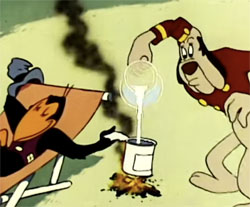 Miami Maniacs (Terrytoons/Fox, Heckle and Jeckle, 2/1/56 – Connie Rasinski, dir.) – Featuring a substantial amount of erratic animation from Jim Tyer, this installment chronicles another of the birds’ migrations South for the winter. This time, however, they’ve arrived in style, comfortably resting in lounge chairs next to a blazing campfire – which they’ve taken the liberty of building upon the grounds of a posh Miami hotel. The unauthorized fire wafts plumes of smoke up into every window of the hotel tower, until the entire building is shaking and vibrating with the hacking and coughing of the building’s occupants. The hotel switchboard lights up, and the bulldog manager answers the phone, receiving both verbal complaints and blasts of black smoke out of the phone receiver. “Get the hose”, the manager orders to bellhop Dimwit. Dimwit runs for a hose mounted on a spool on one wall, grabbing the nozzle and pulling with all his might. But the hose is somehow snagged and won’t completely unspool, and yanks Dimwit backwards into its loops. Dimwit pops himself out of the mess, his body misshapen into the form of a coiled spring. He gives a pull for another try, finally loosening the hose, but too quickly. The canvas unspools with too much slack, piling up in Dimwit’s hands and in broad loops around his shoulders. The manager gets snagged in the loops as Dimwit passes, and is dragged along for the ride outside, with the nozzle periodically clanging a staccato upon his head. The two reach the exterior patio, only to stumble in the tangle of hose and fall in a heap. Dimwit abandons the hose altogether, and, spotting the birds’ campfire, grabs a pitcher of water with which to douse the flames. However, lounging Heckle, who appears to be asleep under his sunglasses, suddenly extends one hand to hold out a water glass, just as Dimwit turns the pitcher to empty it upon the fire. All the water goes into Heckle’s cup, leaving the fire burning, while Heckle thanks the bellhop for his service. The fire is ignored by the characters for the remainder of the film (did it burn itself out, or keep burning?), as H&J make an exit, riding their lounge-chairs as if they were racing steeds, with Heckle commenting, “I love these crazy chases!”
Miami Maniacs (Terrytoons/Fox, Heckle and Jeckle, 2/1/56 – Connie Rasinski, dir.) – Featuring a substantial amount of erratic animation from Jim Tyer, this installment chronicles another of the birds’ migrations South for the winter. This time, however, they’ve arrived in style, comfortably resting in lounge chairs next to a blazing campfire – which they’ve taken the liberty of building upon the grounds of a posh Miami hotel. The unauthorized fire wafts plumes of smoke up into every window of the hotel tower, until the entire building is shaking and vibrating with the hacking and coughing of the building’s occupants. The hotel switchboard lights up, and the bulldog manager answers the phone, receiving both verbal complaints and blasts of black smoke out of the phone receiver. “Get the hose”, the manager orders to bellhop Dimwit. Dimwit runs for a hose mounted on a spool on one wall, grabbing the nozzle and pulling with all his might. But the hose is somehow snagged and won’t completely unspool, and yanks Dimwit backwards into its loops. Dimwit pops himself out of the mess, his body misshapen into the form of a coiled spring. He gives a pull for another try, finally loosening the hose, but too quickly. The canvas unspools with too much slack, piling up in Dimwit’s hands and in broad loops around his shoulders. The manager gets snagged in the loops as Dimwit passes, and is dragged along for the ride outside, with the nozzle periodically clanging a staccato upon his head. The two reach the exterior patio, only to stumble in the tangle of hose and fall in a heap. Dimwit abandons the hose altogether, and, spotting the birds’ campfire, grabs a pitcher of water with which to douse the flames. However, lounging Heckle, who appears to be asleep under his sunglasses, suddenly extends one hand to hold out a water glass, just as Dimwit turns the pitcher to empty it upon the fire. All the water goes into Heckle’s cup, leaving the fire burning, while Heckle thanks the bellhop for his service. The fire is ignored by the characters for the remainder of the film (did it burn itself out, or keep burning?), as H&J make an exit, riding their lounge-chairs as if they were racing steeds, with Heckle commenting, “I love these crazy chases!”
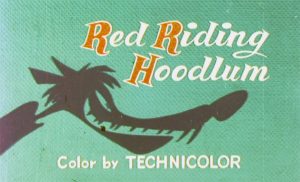 Red Riding Hoodlum (Lantz/Universal, Knothead and Splinter, 2/11/57 – Paul J. Smith, dir.), came into being as a follow-up to the preceding season’s Get Lost, the first starring vehicle for Woody Woodpecker’s nephew and niece, who in all likeligood had already become regular fixtures of his comic book adventures. Voices for both characters are provided by June Foray. While the earlier film, a comic takeoff on Hansel and Gretel, with the birds battling a cat instead of a witch, was reasonably well-written and creative at times, the follow up, now attempting to shoehorn the birds into the story of Red Riding Hood, feels (at least to this author) a bit more forced and strained, with gag material less-prone to score in the belly-laugh department. Consequently, while the original film received frequent airplays, the follow-up was comparatively overlooked by most stations for television play, failed to make home movie release, and proved to be the siblings’ last starring role theatrically (though they would make brief additional supporting appearances in Woody’s “The Unbearable Salesman” and “International Woodpecker”).
Red Riding Hoodlum (Lantz/Universal, Knothead and Splinter, 2/11/57 – Paul J. Smith, dir.), came into being as a follow-up to the preceding season’s Get Lost, the first starring vehicle for Woody Woodpecker’s nephew and niece, who in all likeligood had already become regular fixtures of his comic book adventures. Voices for both characters are provided by June Foray. While the earlier film, a comic takeoff on Hansel and Gretel, with the birds battling a cat instead of a witch, was reasonably well-written and creative at times, the follow up, now attempting to shoehorn the birds into the story of Red Riding Hood, feels (at least to this author) a bit more forced and strained, with gag material less-prone to score in the belly-laugh department. Consequently, while the original film received frequent airplays, the follow-up was comparatively overlooked by most stations for television play, failed to make home movie release, and proved to be the siblings’ last starring role theatrically (though they would make brief additional supporting appearances in Woody’s “The Unbearable Salesman” and “International Woodpecker”).
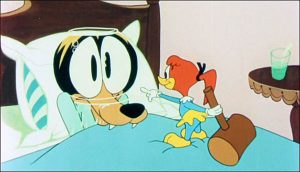 The wolf of the piece is an old Lantz design, in his final theatrical reappearance, reviving Dick Lundy’s “Wolfie” from 1946’s Who’s Cooking Who? Wolfie had reappeared the following year in Fair Weather Fiends, but had not been subsequently used in a Woody cartoon, instead only appearing in a 1953 one-shot, “The Dog That Cried Wolf”, a film originally intended as the comeback for Andy Panda but from which Andy was scratched in the final production. He happens by in the woods as the woodpeckers are on their way to deliver a picnic lunch to their own grandmother in a fairy-tale forest. The birds have just read the story of Red Riding Hood, and recognize the situation as just like the book, deducing that Granny may be put on the spot by the wolf. So, as the wolf takes a short cut, the kids take a short-short cut, and arrive first. They find a real estate boom in progress in the neighborhood (courtesy of developers, “The Real Grim Estates”), such that so many houses have sprung up, they cannot recognize which is Granny’s. They look in at the homes of the Three Pigs, Three Bears, and the Kids in the Shoe, all of whom point them further down the block. For a highly odd twist, the woods just happen to be being patrolled by Smokey the Bear, who informs them that “Granny’s is the next house”. The birds enter to find their Grandma still okay, seated in the pose of Whistler’s Mother. They divert her by asking her to tell them a story, then substitute in place of themselves balloons with their own faces painted upon them, tied to Granny’s feet so that she can see them just above the pages of the book from which she reads. Meanwhile, the wolf finally arrives, going through the same search through everyone else’s houses to get to Granny’s. Mama Bear comments to her family that “Granny must be having a party.” Outside the window, Smokey Bear responds, “I hope they are careful with their cigarettes.” The wolf slips inside and into one of Granny’s nightgowns, and the kids, lying in wait, pretend to enter, playing along with the gag. Wolfie complains of being laid up with that dog-gone “malnutrition”. Knothead drops a goldfish bowl on his head, prompting Splinter to utter the inevitable line “What big eyes you have” at their distorted look through the bowl glass.
The wolf of the piece is an old Lantz design, in his final theatrical reappearance, reviving Dick Lundy’s “Wolfie” from 1946’s Who’s Cooking Who? Wolfie had reappeared the following year in Fair Weather Fiends, but had not been subsequently used in a Woody cartoon, instead only appearing in a 1953 one-shot, “The Dog That Cried Wolf”, a film originally intended as the comeback for Andy Panda but from which Andy was scratched in the final production. He happens by in the woods as the woodpeckers are on their way to deliver a picnic lunch to their own grandmother in a fairy-tale forest. The birds have just read the story of Red Riding Hood, and recognize the situation as just like the book, deducing that Granny may be put on the spot by the wolf. So, as the wolf takes a short cut, the kids take a short-short cut, and arrive first. They find a real estate boom in progress in the neighborhood (courtesy of developers, “The Real Grim Estates”), such that so many houses have sprung up, they cannot recognize which is Granny’s. They look in at the homes of the Three Pigs, Three Bears, and the Kids in the Shoe, all of whom point them further down the block. For a highly odd twist, the woods just happen to be being patrolled by Smokey the Bear, who informs them that “Granny’s is the next house”. The birds enter to find their Grandma still okay, seated in the pose of Whistler’s Mother. They divert her by asking her to tell them a story, then substitute in place of themselves balloons with their own faces painted upon them, tied to Granny’s feet so that she can see them just above the pages of the book from which she reads. Meanwhile, the wolf finally arrives, going through the same search through everyone else’s houses to get to Granny’s. Mama Bear comments to her family that “Granny must be having a party.” Outside the window, Smokey Bear responds, “I hope they are careful with their cigarettes.” The wolf slips inside and into one of Granny’s nightgowns, and the kids, lying in wait, pretend to enter, playing along with the gag. Wolfie complains of being laid up with that dog-gone “malnutrition”. Knothead drops a goldfish bowl on his head, prompting Splinter to utter the inevitable line “What big eyes you have” at their distorted look through the bowl glass.
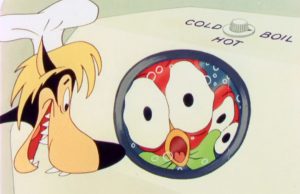 Splinter whacks the wolf from behind the head, knocking out his false teeth – allowing Knothead to utter the “What big teeth you have” line to the dentures on the floor. The usual chase ensues. In one sequence, while the kids appear to be trapped inside a washing machine set to a temperature of “Boil”, the wolf makes ready a dinner table, lighting a set of candles for dinner. From outside, Smokey the Bear again intervenes. “Carelessness with matches results in loss to everyone.” The wolf looks around for a place to dispose of the match used to light the candles, then, finding none, swallows the lit match whole with a painful gulp, and gives the nosy Smokey a dirty look for his troubles. The film’s odd ending borrows from two previous Riding Hood spoofs from other studios. Granny emerges from the living room, and comes face to face with Wolfie. “A wolf!”, she exclaims. She immediately runs to her dresser and dolls herself up with wig, false eyelashes, and make-up – as if administering to herself a dose of “Jazz Tonic” as Grandma did in Van Buren’s Red Riding Hood (1931), then locks the wolf in a kissing embrace. The last shot has the kids observing that this picture’s ending is nothing like the book, as they hold the train of the bridal gown of Granny at a marriage ceremony – to the wolf – in a shot that looks like an absolute twin to the censored alternate ending for Tex Avery’s Red Hot Riding Hood (1943), suggesting that photograph of the lost ending cel (still known to historians today) got around in the industry – perhaps from Avery’s own involvement at the Lantz studio from his personal files – so as to be lifted by Smith for this film.
Splinter whacks the wolf from behind the head, knocking out his false teeth – allowing Knothead to utter the “What big teeth you have” line to the dentures on the floor. The usual chase ensues. In one sequence, while the kids appear to be trapped inside a washing machine set to a temperature of “Boil”, the wolf makes ready a dinner table, lighting a set of candles for dinner. From outside, Smokey the Bear again intervenes. “Carelessness with matches results in loss to everyone.” The wolf looks around for a place to dispose of the match used to light the candles, then, finding none, swallows the lit match whole with a painful gulp, and gives the nosy Smokey a dirty look for his troubles. The film’s odd ending borrows from two previous Riding Hood spoofs from other studios. Granny emerges from the living room, and comes face to face with Wolfie. “A wolf!”, she exclaims. She immediately runs to her dresser and dolls herself up with wig, false eyelashes, and make-up – as if administering to herself a dose of “Jazz Tonic” as Grandma did in Van Buren’s Red Riding Hood (1931), then locks the wolf in a kissing embrace. The last shot has the kids observing that this picture’s ending is nothing like the book, as they hold the train of the bridal gown of Granny at a marriage ceremony – to the wolf – in a shot that looks like an absolute twin to the censored alternate ending for Tex Avery’s Red Hot Riding Hood (1943), suggesting that photograph of the lost ending cel (still known to historians today) got around in the industry – perhaps from Avery’s own involvement at the Lantz studio from his personal files – so as to be lifted by Smith for this film.
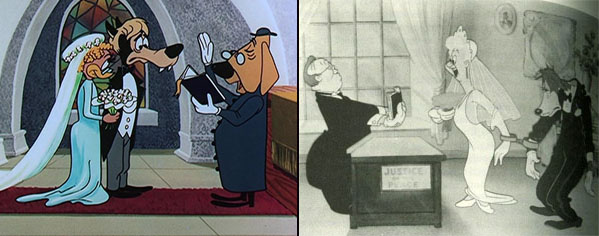
Red Riding Hoodlum (left) and the lost scene from Avery’s Red Hot Riding Hood (1943, right)
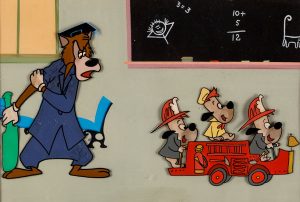 Blackboard Jumble (MGM, Droopy, 10/4/57 – Michael Lah, dir.), has been previously visited in out “Back to School” trail. It is a comeback for Daws Bitler’s southern-accented slow-talking wolf, and the “Three Little Pups” introduced in Tex Avery’s film of the same title, now in an academic setting, as the wolf is inducted as new substitute teacher for a grammar school class when the original professor goes berserk thanks to the kids’ destructive antics. The wolf is the perfect candidate for the job, as the old professor observes between intermittent fits that anyone who wants this teaching job “would have to be an idiot.” Amidst a barrage of flying books and assorted weapons, the wolf assumes his position to provide some “modern education”, on such advanced subjects as “finger painting”. He has the boys paint a Confederate flag, but observes “You forgot the stars.” A conk on the head by one of the pups provides them instantly, from the teacher’s brow. “There’s a cotton’ pickin’ Yankee in this crowd”, notes the wolf. After the boys hammer the teacher into hopeless knots through a natural aptitude table, and spring a bear trap upon his rear end placed upon his seat, the wolf proceeds to a wall rack of large paddles, declaring, “If modern education don’t work, you gotta apply a little old-fashioned education.” He picks up one of the pups, and is about to administer some corporal punishment, when another of the kids sidetracks him by giving him a hotfoot. As the wolf hops around in considerable pain with a foot on fire, the other two pups arrive on the scene in a kiddie-car fire engine. They raise a small ladder up to the wolf’s side, climb up, and pluck away the third pup from the teacher’s grasp, then merely drive away into the coat room, providing the teacher no quenching relief for his flaming hotfoot. A few more minutes of this kind of beating, and the wolf is ready to follow the trail of the previous professor to the funny farm, declaring of his supply of patience, “Man, I ain’t got any more.”
Blackboard Jumble (MGM, Droopy, 10/4/57 – Michael Lah, dir.), has been previously visited in out “Back to School” trail. It is a comeback for Daws Bitler’s southern-accented slow-talking wolf, and the “Three Little Pups” introduced in Tex Avery’s film of the same title, now in an academic setting, as the wolf is inducted as new substitute teacher for a grammar school class when the original professor goes berserk thanks to the kids’ destructive antics. The wolf is the perfect candidate for the job, as the old professor observes between intermittent fits that anyone who wants this teaching job “would have to be an idiot.” Amidst a barrage of flying books and assorted weapons, the wolf assumes his position to provide some “modern education”, on such advanced subjects as “finger painting”. He has the boys paint a Confederate flag, but observes “You forgot the stars.” A conk on the head by one of the pups provides them instantly, from the teacher’s brow. “There’s a cotton’ pickin’ Yankee in this crowd”, notes the wolf. After the boys hammer the teacher into hopeless knots through a natural aptitude table, and spring a bear trap upon his rear end placed upon his seat, the wolf proceeds to a wall rack of large paddles, declaring, “If modern education don’t work, you gotta apply a little old-fashioned education.” He picks up one of the pups, and is about to administer some corporal punishment, when another of the kids sidetracks him by giving him a hotfoot. As the wolf hops around in considerable pain with a foot on fire, the other two pups arrive on the scene in a kiddie-car fire engine. They raise a small ladder up to the wolf’s side, climb up, and pluck away the third pup from the teacher’s grasp, then merely drive away into the coat room, providing the teacher no quenching relief for his flaming hotfoot. A few more minutes of this kind of beating, and the wolf is ready to follow the trail of the previous professor to the funny farm, declaring of his supply of patience, “Man, I ain’t got any more.”
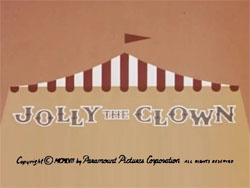 Jolly the Clown (Paramount/Famous, Noveltoon, 10/25/57 – Seymour Kneitel, dir.) – A fun venture by the studio into its new cost-cutting period of stylized animation, attempting to capitalize upon the rising popularity of the work of UPA. In this one, the character designs remain still quite appealing, and much of their animation continues to be quite fluid, though backgrounds are largely minimalistic with solid colors and geometric patterning for floodlights. Our title character is the star performer of the circus (talking only in squeaks that resemble the traditional voice of the star puppet of a Punch and Judy show), with a fairly-clever act of his own, entering in a clown car that couldn’t rightfully hold any driver larger than Herman the Mouse, yet unfolding from the driver’s seat before the audience’s eyes. He sets up a sales table as a street hawker, and demonstrates a hair-growing formula upon his bald dome (which sprouts a large flower from his scalp instead). Cutaways to the audience reaction present the interesting touch of everyone laughing uproariously, except for one bespectacled man in the center, who just sits stoically. (Could this have been an in-joke depicting someone at the studio who had no sense of humor?) As Jiminy Cricket once said, “Well, you can’t please everybody.” A pair of keystone cop clowns enter to break up Jolly’s unlicensed sales pitch, and Jolly retreats to his miniature car, then extends his full-size feet through its floorboards, to beat a hasty exit out of the circus tent. The crowd cheers again, and the show moves on to its next act – little Ellsworth Elephant, whose act consists of balancing atop a rolling barrel across the arena, up onto a teeterboard. Unfortunately, this is not his day for gracefulness.
Jolly the Clown (Paramount/Famous, Noveltoon, 10/25/57 – Seymour Kneitel, dir.) – A fun venture by the studio into its new cost-cutting period of stylized animation, attempting to capitalize upon the rising popularity of the work of UPA. In this one, the character designs remain still quite appealing, and much of their animation continues to be quite fluid, though backgrounds are largely minimalistic with solid colors and geometric patterning for floodlights. Our title character is the star performer of the circus (talking only in squeaks that resemble the traditional voice of the star puppet of a Punch and Judy show), with a fairly-clever act of his own, entering in a clown car that couldn’t rightfully hold any driver larger than Herman the Mouse, yet unfolding from the driver’s seat before the audience’s eyes. He sets up a sales table as a street hawker, and demonstrates a hair-growing formula upon his bald dome (which sprouts a large flower from his scalp instead). Cutaways to the audience reaction present the interesting touch of everyone laughing uproariously, except for one bespectacled man in the center, who just sits stoically. (Could this have been an in-joke depicting someone at the studio who had no sense of humor?) As Jiminy Cricket once said, “Well, you can’t please everybody.” A pair of keystone cop clowns enter to break up Jolly’s unlicensed sales pitch, and Jolly retreats to his miniature car, then extends his full-size feet through its floorboards, to beat a hasty exit out of the circus tent. The crowd cheers again, and the show moves on to its next act – little Ellsworth Elephant, whose act consists of balancing atop a rolling barrel across the arena, up onto a teeterboard. Unfortunately, this is not his day for gracefulness.
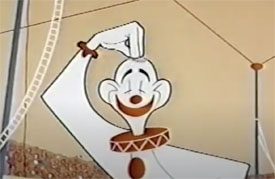 As he attempts to balance the barrel at the center point of the teeterboard above the fulcrum, he slips, landing off to one sude of the board, while his barrel lands on the opposite end. Ellsworth’s weight catapults the barrel into the air – right onto the head of the ringmaster. The flustered boss utters the dreaded words, “You’re fired!” to Ellsworth, and the poor elephant leaves the tent in disgrace. All this time, Jolly has been watching the act from just outside the tent, through a pair of large oversized eyeglasses. He is so moved emotionally by Ellsworth’s firing, that he begins to weep, and removes the eyeglasses to wring out from them a flood of tears. Ellsworth emerges slowly, his head drooping in shame, and Jolly calls for him to wait up. Seeing Ellsworth crying too, Jolly produces from his pocket a cloth the size of a large blanket, upon which is printed the word “Hanky”, and dries Ellsworth’s tears with it. Patting the elephant on the head, Jolly disappears off screen for an instant, returning with a new barrel for Ellsworth to stand on, and a small platform upon a pole, with a suction cup on the other end for Ellsworth to balance upon his head – all with an idea for a new act. As Ellsworth assumes his position upon the barrel with the platform stuck to his head, Jolly climbs up onto the platform, carrying several oversized matchsticks and a huge firecracker. Once standing above, Jolly tells Ellsworth to begin barrel-rolling, while Jolly blindfolds himself. Jolly then balances the firecracker on his head, strikes the matches against his foot, and begins juggling the lighted matches in a circle around the firecracker. Intentionally, he allows the matches to descend into a tighter and tighter circle, until one of them makes contact with the fuse of the firecracker and ignites it. Jolly removes the blindfold, then squeaks to Ellsworth, “Okay, put me down.” Ellsworth obliges, lowering Jolly with his trunk to the ground. Jolly takes a bow to an imaginary audience, but Ellsworth panics when he sees the lit firecracker on Jolly’s head. Grabbing it with his trunk, he holds it out to Jolly, in body language that definitely suggests, “What do we do now?” Calmly, Jolly reaches out, and plucks the wick out of the top of the firecracker – entirely removeable – and holds it between his fingers until it reaches its end and poofs out, Jolly flipping away the last whiffs with a flourish of his fingers. Jolly then laughs, and shakes hands – that is, trunk – with Ellsworth, as the two form a new partnership.
As he attempts to balance the barrel at the center point of the teeterboard above the fulcrum, he slips, landing off to one sude of the board, while his barrel lands on the opposite end. Ellsworth’s weight catapults the barrel into the air – right onto the head of the ringmaster. The flustered boss utters the dreaded words, “You’re fired!” to Ellsworth, and the poor elephant leaves the tent in disgrace. All this time, Jolly has been watching the act from just outside the tent, through a pair of large oversized eyeglasses. He is so moved emotionally by Ellsworth’s firing, that he begins to weep, and removes the eyeglasses to wring out from them a flood of tears. Ellsworth emerges slowly, his head drooping in shame, and Jolly calls for him to wait up. Seeing Ellsworth crying too, Jolly produces from his pocket a cloth the size of a large blanket, upon which is printed the word “Hanky”, and dries Ellsworth’s tears with it. Patting the elephant on the head, Jolly disappears off screen for an instant, returning with a new barrel for Ellsworth to stand on, and a small platform upon a pole, with a suction cup on the other end for Ellsworth to balance upon his head – all with an idea for a new act. As Ellsworth assumes his position upon the barrel with the platform stuck to his head, Jolly climbs up onto the platform, carrying several oversized matchsticks and a huge firecracker. Once standing above, Jolly tells Ellsworth to begin barrel-rolling, while Jolly blindfolds himself. Jolly then balances the firecracker on his head, strikes the matches against his foot, and begins juggling the lighted matches in a circle around the firecracker. Intentionally, he allows the matches to descend into a tighter and tighter circle, until one of them makes contact with the fuse of the firecracker and ignites it. Jolly removes the blindfold, then squeaks to Ellsworth, “Okay, put me down.” Ellsworth obliges, lowering Jolly with his trunk to the ground. Jolly takes a bow to an imaginary audience, but Ellsworth panics when he sees the lit firecracker on Jolly’s head. Grabbing it with his trunk, he holds it out to Jolly, in body language that definitely suggests, “What do we do now?” Calmly, Jolly reaches out, and plucks the wick out of the top of the firecracker – entirely removeable – and holds it between his fingers until it reaches its end and poofs out, Jolly flipping away the last whiffs with a flourish of his fingers. Jolly then laughs, and shakes hands – that is, trunk – with Ellsworth, as the two form a new partnership.
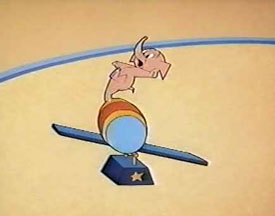 Inside, the ringmaster is in the process of introducing an acrobatic act, with several items of the team’s equipment already set up around the arena. Before he can even state the name of the performers, there is an uprising of laughter from the audience, as Ellsworth makes an unexpected appearance from the tent entrance with his barrel and platform, followed by a dancing, prancing Jolly. As Ellsworth rolls into one of the performance rings, the frustrated ringmaster advances upon him to throw him out again. However, Jolly slips up behind the ringmaster, attaching to his coattails a hook tied to a rope threaded through a pulley high upon one of the tent poles. Jolly pulls on the other end of the rope, hoisting the ringmaster to a position above one of the trapeze platforms high upon the pole, then ties off the rope end to the base of the pole, leaving the ringmaster stranded above, shouting for someone to get him down. Jolly then mounts Ellsworth’s platform, and begins his blindfolded juggling act. A new fuse in the firecracker is again ignited by the matches. But before Ellsworth can set Jolly down on the ground, he back-rolls his barrel into an unexpected obstacle – a teeterboard left by the acrobatic act, on one end of which rests a strongman’s barbell.
Inside, the ringmaster is in the process of introducing an acrobatic act, with several items of the team’s equipment already set up around the arena. Before he can even state the name of the performers, there is an uprising of laughter from the audience, as Ellsworth makes an unexpected appearance from the tent entrance with his barrel and platform, followed by a dancing, prancing Jolly. As Ellsworth rolls into one of the performance rings, the frustrated ringmaster advances upon him to throw him out again. However, Jolly slips up behind the ringmaster, attaching to his coattails a hook tied to a rope threaded through a pulley high upon one of the tent poles. Jolly pulls on the other end of the rope, hoisting the ringmaster to a position above one of the trapeze platforms high upon the pole, then ties off the rope end to the base of the pole, leaving the ringmaster stranded above, shouting for someone to get him down. Jolly then mounts Ellsworth’s platform, and begins his blindfolded juggling act. A new fuse in the firecracker is again ignited by the matches. But before Ellsworth can set Jolly down on the ground, he back-rolls his barrel into an unexpected obstacle – a teeterboard left by the acrobatic act, on one end of which rests a strongman’s barbell.
Ellsworth falls from his barrel, landing on the opposite end of the teeterboard, and flips the barbell into the air, which collides with Jolly. Jolly is knocked to the other side of the ring, temporarily dazed, while the firecracker, still burning, lands in the center of the ring between them. Both Ellsworth and Jolly come to their senses, and react in shock takes at observing the ever-shortening fuse (Jolly’s take springs his bare feet out the bottoms of his oversize clown shoes). Ellsworth locates a broom resting against a tent pole, grabs it up with his trunk, and charges the firecracker in an attempt to snuff it out, while Jolly advances in the opposite direction. Ellsworth swats at the firecracker, but accidentally hits a trapeze release above with his broom instead. The trapeze catches Jolly under the chin and flips him upwards into the air, while the misdirected follow-through of Ellsworth’s swat flips the firecracker onto a trampoline. “They’re ruining the show”, moans the ringmaster from above, struggling to get his coat loose from the hook. Ellsworth mounts the trampoline to take another swat at the wick, but Jolly swings into the shot from the trapeze, landing directly behind Ellsworth, and unintentionally bouncing Ellsworth and the firecracker high into the air. Both collide with the bottom side of a trapeze platform above, and as Ellsworth falls, he discovers the firecracker has now compressed into and become firmly stuck inside his trunk. The poor elephant faints, while Jolly hastens to the rescue, positioning under Ellsworth a tall stack of acrobatic platforms, piled one on top of the other to a height of about one dozen. Ellsworth lands in a collapse on the top platform, while Jolly kicks away one platform after another from the stack to bring the elephant down one step at a time. The outraged ringmaster meanwhile finally gets his coat loose, lands on the pole platform below him, and begins to climb his way back down to the ground. The final platform is kicked out from under Ellsworth, and Jolly at last gets a grip on the firecracker, extracts it from Ellsworth’s trunk, and does the remove-the-wick trick and finger flourish to prevent the explosion. The crown erupts in ecstatic cheers and applause, but the ringmaster, arriving on the scene, is at first too angry to hear. Grabbing up both Jolly and Ellsworth, he shouts “You’re both fired!”, but then pauses, as the reaction of the crowd finally reaches his ears. Looking around the arena, the ringmaster realizes that the duo has come up with a real crowd-pleaser, and his entire disposition changes as to the boys, as he too joins in the applause. “Great act. Wonderful, wonderful. Bravo!”, he says in congratulations, all anger forgotten. No one, however, notices that the firecracker, standing nearby, has this time retained some embers from the removed wick, and begins to smolder inside the wick hole. BOOOOM! When the smoke clears, the ringmaster is well blackened, with half of his outfit blasted away – yet, he continues to applaud the boys on their audience success. “Terrific act. The best yet!”, as the audience continues to applaud, and Ellsworth and Jolly, their future secured, take their final bows for the fade out.
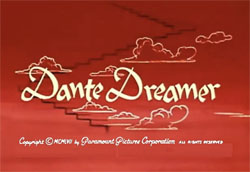 Dante Dreamer (Paramount/Famous, Noveltoon, 1/3/58 – I. Sparber, dir.). Possibly the most extremely-stylized cartoon ever produced by the studio in its mock-UPA period, with two human characters (a boy and his mother) drawn with matching solid swatches of red hair that nearly always cover one eye completely. making them often appear to be some sort of cyclops. (Well, the look worked for Popeye, even without hair.) Rigid angular posing, and sparse backgrounds often only suggesting objects or landscapes by geometric forms of solid color, complete the strange modernistic design. The story, provided by Jack Mercer, is certainly one of his most off-the-wall creations, though punched-up with several good sight gags. The boy is referred to as Dante, but not pronounced in the usual manner of the inhabitant of the Inferno, instead with the “A” of the first syllable stated more like the longer-A of a sheep’s bleat than “Dahn”. The first few times I saw the film, it was a bit off-putting, especially when presented amidst the usual run of Caspers and Herman and Katnips. With time and closer examination of the script material, it starts to grow on you – though one can only speculate if original audiences had the time and patience for such a process to occur during their one sitting.
Dante Dreamer (Paramount/Famous, Noveltoon, 1/3/58 – I. Sparber, dir.). Possibly the most extremely-stylized cartoon ever produced by the studio in its mock-UPA period, with two human characters (a boy and his mother) drawn with matching solid swatches of red hair that nearly always cover one eye completely. making them often appear to be some sort of cyclops. (Well, the look worked for Popeye, even without hair.) Rigid angular posing, and sparse backgrounds often only suggesting objects or landscapes by geometric forms of solid color, complete the strange modernistic design. The story, provided by Jack Mercer, is certainly one of his most off-the-wall creations, though punched-up with several good sight gags. The boy is referred to as Dante, but not pronounced in the usual manner of the inhabitant of the Inferno, instead with the “A” of the first syllable stated more like the longer-A of a sheep’s bleat than “Dahn”. The first few times I saw the film, it was a bit off-putting, especially when presented amidst the usual run of Caspers and Herman and Katnips. With time and closer examination of the script material, it starts to grow on you – though one can only speculate if original audiences had the time and patience for such a process to occur during their one sitting.

“Dante Dreamer” (1958)
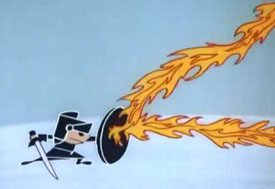 From inside, Dante takes hold of the dragon’s spiked tail, bending it around to point at the dragon’s rear, then jabs the tail barb fiercely into the dragon’s most tender regions. The dragon screams in pain, opening his mouth long enough for Dante to exit again. Dante descends to the ground by means of the dragon’s tongue, extending and retracting it like a rolling windowshade. It’s the dragon’s turn for an offensive, exhaling one of his largest fireballs, which develops a flaming hand in an attempt to grab at Dante. Dante evades the grasp, but smacks head-on into the side of a well foundation, briefly flattening the boy’s armor into the shape of a spinning coin. Dante pops back to normal shape, and seizes the well’s bucket, full of water, to hurl at the dragon. The dragon swallows the brew, and a hiss is heard from within his throat, as his flame is quenched, down to a final small puff of black smoke. But the dragon is not licked yet. Being an incinerator in reality, he spots a bin of coal, so opens up a steel grating in his belly, stokes his interior with the black rocks, lights a match, and drops in a sheet of burning tissue paper – all of which immediately restokes him to full fire capacity. Dante will need more help, and spies nearby a wooden sawhorse with a shovel resting against it. Imagination comes to the rescue again, transforming the objects into a live horse and lance. Dante leaps aboard and sets himself for a charge. The dragon takes a chomp at the horse’s head. Fortunately, the steed’s head is retractable – and reversible with his tail, allowing the horse to protect his noggin like a turtle, retreat to strategic position, then reverse his head and tail to face the dragon for another charge. The horse and dragon collide head-on. When the dust clears, the dragon finds himself riding the horse. The surprised horse bucks, tossing the dragon to the ground ahead of him, as Dante mounts again, and strikes while the dragon is down, piercing the dragon’s belly with the lance for a final death blow. A call from mom out the window awakens Dante to the matter of completing his trash-burning task, restoring the backyard and Dante to everyday normality. However, as Dante drops the trash inside the incinerator, he forgets to latch the grating door, which flips open, allowing a jet of flame to singe the seat of Dante’s pants. Dante runs yelling for mama, and informs her how a dragon was pursuing him around the yard, Mom scolds him: ”You and your imagination!” “Oh yeah?”, replies Dante, turning to prove that he didn’t imagine the burnt-out seat of his pants, for the fade out.
From inside, Dante takes hold of the dragon’s spiked tail, bending it around to point at the dragon’s rear, then jabs the tail barb fiercely into the dragon’s most tender regions. The dragon screams in pain, opening his mouth long enough for Dante to exit again. Dante descends to the ground by means of the dragon’s tongue, extending and retracting it like a rolling windowshade. It’s the dragon’s turn for an offensive, exhaling one of his largest fireballs, which develops a flaming hand in an attempt to grab at Dante. Dante evades the grasp, but smacks head-on into the side of a well foundation, briefly flattening the boy’s armor into the shape of a spinning coin. Dante pops back to normal shape, and seizes the well’s bucket, full of water, to hurl at the dragon. The dragon swallows the brew, and a hiss is heard from within his throat, as his flame is quenched, down to a final small puff of black smoke. But the dragon is not licked yet. Being an incinerator in reality, he spots a bin of coal, so opens up a steel grating in his belly, stokes his interior with the black rocks, lights a match, and drops in a sheet of burning tissue paper – all of which immediately restokes him to full fire capacity. Dante will need more help, and spies nearby a wooden sawhorse with a shovel resting against it. Imagination comes to the rescue again, transforming the objects into a live horse and lance. Dante leaps aboard and sets himself for a charge. The dragon takes a chomp at the horse’s head. Fortunately, the steed’s head is retractable – and reversible with his tail, allowing the horse to protect his noggin like a turtle, retreat to strategic position, then reverse his head and tail to face the dragon for another charge. The horse and dragon collide head-on. When the dust clears, the dragon finds himself riding the horse. The surprised horse bucks, tossing the dragon to the ground ahead of him, as Dante mounts again, and strikes while the dragon is down, piercing the dragon’s belly with the lance for a final death blow. A call from mom out the window awakens Dante to the matter of completing his trash-burning task, restoring the backyard and Dante to everyday normality. However, as Dante drops the trash inside the incinerator, he forgets to latch the grating door, which flips open, allowing a jet of flame to singe the seat of Dante’s pants. Dante runs yelling for mama, and informs her how a dragon was pursuing him around the yard, Mom scolds him: ”You and your imagination!” “Oh yeah?”, replies Dante, turning to prove that he didn’t imagine the burnt-out seat of his pants, for the fade out.
Notably, this film was preceded by a production from a rival studio of a few years earlier, Jack Hannah’s “Dragon Around” from Disney with Donald Duck and Chip and Dale, in which the chipmunks believe Donald’s steam-shovel to be a dragon. No doubt the Disney production provided inspiration for the Paramount story. While our imaginations are running rampant, it would be interesting to imagine what the “Dante” script might have looked like in the hands of Hannah, and how much better its gags might have scored with full animation, crisper timing, and detailed medieval backgrounds to add real atmosphere.
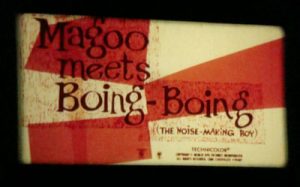 Magoo Meets Boing Boing (The Noise Making Boy) (UPA, Mister Magoo, 12/27/59 – Abe Levitow, dir.), is one of a handful of Magoos which received limited theatrical release in an attempt to independently release cartoons after losing the Columbia distribution contract the studio had flourished under since the character’s inception. It eventually found wide release as part of the television package of Magoo films circulating in the 1960’s, shortened in running length, and with the shortened title “Magoo Meets McBoing Boing”. It marks the first meeting of Magoo with the studio’s only other major star, Gerald McBoing Boing, Dr. Seuss’s boy who speaks only sound effects instead of words. Their actual on-screen time together is fairly brief, due to a typical Magoo misunderstanding, and Gerald definitely takes a back seat in this one to Magoo’s antics. The two would meet only once more, in the television special “Mister Magoo’s Christmas Carol”, where Gerald would drop his sound-effects entirely and miraculously learn to talk normally, to step into the stage role of Tiny Tim. Gerald had otherwise only talked once in the original series (in “How Now Boing Boing”), through the elaborate aid of a two-way international telephone signal-deciphering machine. If one was used to provide him with voice for the Christmas Carol performance, the long-distance bill must have been astronomical.
Magoo Meets Boing Boing (The Noise Making Boy) (UPA, Mister Magoo, 12/27/59 – Abe Levitow, dir.), is one of a handful of Magoos which received limited theatrical release in an attempt to independently release cartoons after losing the Columbia distribution contract the studio had flourished under since the character’s inception. It eventually found wide release as part of the television package of Magoo films circulating in the 1960’s, shortened in running length, and with the shortened title “Magoo Meets McBoing Boing”. It marks the first meeting of Magoo with the studio’s only other major star, Gerald McBoing Boing, Dr. Seuss’s boy who speaks only sound effects instead of words. Their actual on-screen time together is fairly brief, due to a typical Magoo misunderstanding, and Gerald definitely takes a back seat in this one to Magoo’s antics. The two would meet only once more, in the television special “Mister Magoo’s Christmas Carol”, where Gerald would drop his sound-effects entirely and miraculously learn to talk normally, to step into the stage role of Tiny Tim. Gerald had otherwise only talked once in the original series (in “How Now Boing Boing”), through the elaborate aid of a two-way international telephone signal-deciphering machine. If one was used to provide him with voice for the Christmas Carol performance, the long-distance bill must have been astronomical.
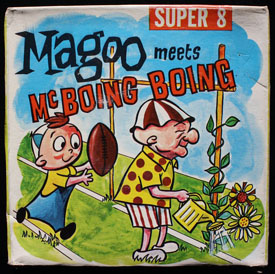 The McCloys (Gerald’s parents) are desperate, attempting to attend a PTA meeting, but having nearly run out of baby sitters to call, all of them being unavailable for the evening. The last name on their list – probably the last uncalled citizen in their community – is Mr. Magoo. Mrs. McCloy’s eyes spiral in dread at hearing his name mentioned by her husband, but Mr. McCloy sees no risk in the selection, observing “Our insurance is paid up.” Magoo answers the call in typical fashion, speaking into the globes of an old chandelier as if the phone’s mouthpiece. Arriving at the McCloy home, Magoo is too busy ushering the parents out to hear Mr. McCloy’s attempt to inform Magoo that Gerald doesn’t speak words. While Gerald busies himself in the living room playing with a miniature toy fire engine, Magoo mistakenly grabs up the family dog, climbing up the steps with him in belief he is holding Gerald, intending to tuck him into bed. Magoo mixes a baby formula, mistaking a wine cabinet for a kitchen cupboard, and retrieving a bottle of cooking sherry as the primary ingredient. Bu the time he is through, he has heated on a radiator a wine glass with an alcoholic mixture within, topped by a baby bottle nipple, which he provides to the dog. The dog burps over Magoo’s shoulder – or was that an intoxicated hiccup? Meanwhile, between trips up and down stairs, Magoo has encountered Gerald on the living room rug, and, believing him to be the dog, sets Gerald outside on the porch to “guard the master’s house”. Unable to speak in response, Gerald produces noises like scratching on the door, reinforcing Magoo’s belief that he has just put out the dog. Gerald attempts to regain entry by climbing a tall trellis from the porch up to a second-story window. On the way up, Gerald begins to make the sounds of a fire-engine siren, as he had been doing in his play in the living room. Magoo is just descending the stairs inside, and observes that the house is getting very hot – then hears the sound of the siren. “The house is on fire! Save the child!”, he shouts. Racing back upstairs, he grabs the dog, ties bedsheets together, and attempt to escape out the bedroom window.
The McCloys (Gerald’s parents) are desperate, attempting to attend a PTA meeting, but having nearly run out of baby sitters to call, all of them being unavailable for the evening. The last name on their list – probably the last uncalled citizen in their community – is Mr. Magoo. Mrs. McCloy’s eyes spiral in dread at hearing his name mentioned by her husband, but Mr. McCloy sees no risk in the selection, observing “Our insurance is paid up.” Magoo answers the call in typical fashion, speaking into the globes of an old chandelier as if the phone’s mouthpiece. Arriving at the McCloy home, Magoo is too busy ushering the parents out to hear Mr. McCloy’s attempt to inform Magoo that Gerald doesn’t speak words. While Gerald busies himself in the living room playing with a miniature toy fire engine, Magoo mistakenly grabs up the family dog, climbing up the steps with him in belief he is holding Gerald, intending to tuck him into bed. Magoo mixes a baby formula, mistaking a wine cabinet for a kitchen cupboard, and retrieving a bottle of cooking sherry as the primary ingredient. Bu the time he is through, he has heated on a radiator a wine glass with an alcoholic mixture within, topped by a baby bottle nipple, which he provides to the dog. The dog burps over Magoo’s shoulder – or was that an intoxicated hiccup? Meanwhile, between trips up and down stairs, Magoo has encountered Gerald on the living room rug, and, believing him to be the dog, sets Gerald outside on the porch to “guard the master’s house”. Unable to speak in response, Gerald produces noises like scratching on the door, reinforcing Magoo’s belief that he has just put out the dog. Gerald attempts to regain entry by climbing a tall trellis from the porch up to a second-story window. On the way up, Gerald begins to make the sounds of a fire-engine siren, as he had been doing in his play in the living room. Magoo is just descending the stairs inside, and observes that the house is getting very hot – then hears the sound of the siren. “The house is on fire! Save the child!”, he shouts. Racing back upstairs, he grabs the dog, ties bedsheets together, and attempt to escape out the bedroom window.
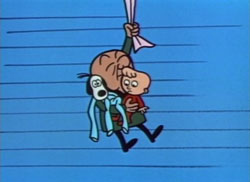 As the McCloys return home, they witness the perilous sight of Gerald high up on the spindly trellis, and Magoo and the dog dangling from the sheets out the window, which are too short to reach the ground. Just at that moment, Gerald leans too far toward the edge of the trellis closest to the window, and a piece of the structure breaks off in Gerald’s hand. Magoo, believing Gerald to be the dog, swings on the bedsheets to one side, catching Gerald just before he falls, then announces to anyone below that he is gong to jump. Holding Gerald and the dog, Magoo lets go of the sheets, landing in a small inflated wading pool only a few feet below. Magoo complains that the firemen carelessly let the safety net get wet. The McCloys, unaware of Magoo’s mix-ups, are overjoyed to have their boy back safe and sound, while Magoo reaches down to pet Gerald’s head, still believing him to be a dog. Gerald humors Magoo’s belief, by responding with a dog bark. The flash of a newspaper cameraman’s flash bulb hits Magoo in the eyes, and Magoo becomes front-page news as a local hero. However, Magoo never even realizes his five minutes of fame, misreading the headlines over his picture at the newsstand as “Man Robs Bank”. He walks away down the street, commenting upon his own photo, “The perfect criminal type. You can tell one, every time.”
As the McCloys return home, they witness the perilous sight of Gerald high up on the spindly trellis, and Magoo and the dog dangling from the sheets out the window, which are too short to reach the ground. Just at that moment, Gerald leans too far toward the edge of the trellis closest to the window, and a piece of the structure breaks off in Gerald’s hand. Magoo, believing Gerald to be the dog, swings on the bedsheets to one side, catching Gerald just before he falls, then announces to anyone below that he is gong to jump. Holding Gerald and the dog, Magoo lets go of the sheets, landing in a small inflated wading pool only a few feet below. Magoo complains that the firemen carelessly let the safety net get wet. The McCloys, unaware of Magoo’s mix-ups, are overjoyed to have their boy back safe and sound, while Magoo reaches down to pet Gerald’s head, still believing him to be a dog. Gerald humors Magoo’s belief, by responding with a dog bark. The flash of a newspaper cameraman’s flash bulb hits Magoo in the eyes, and Magoo becomes front-page news as a local hero. However, Magoo never even realizes his five minutes of fame, misreading the headlines over his picture at the newsstand as “Man Robs Bank”. He walks away down the street, commenting upon his own photo, “The perfect criminal type. You can tell one, every time.”
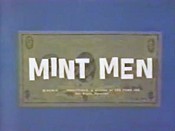 Mint Men (Terrytoons/Fox, Heckle and Jeckle, 5/1/60 – Dave Tendlar, dir.) – It’s hard to say whether the original script for this film started out as something else entirely, and morphed into the tale of two undercover government agents who test the capabilities of a security robot designed to guard the U.S. Mint from theft. Heckle and Jeckle’s usual larcenous spirit may have been more appropriately channeled as a pair of actual would-be thieves rather than merely posing as such to provide a necessary governmental service. It is thus possible that some story man originally conceived this cartoon with the boys attempting unsuccessfully to help themselves to some free currency – but cooler heads decided to cast the boys in a good light rather than as outright felonious thieves. Whatever their original motivations, it at least makes sense, under the principle of “It Takes a Thief…”, that H&J would be the most qualified to test a security machine on the side of the law, being about the most-qualified at the art of breaking the law and busting throough security by reason of their past natural tendencies. Thus, while a bit of over-narration of the episode potentially masks a substantial script rewrite to fit the birds’ new and “noble” agenda, any change in the storyline comes out survivable and reasonably plausible – perhaps even more so to present-day audiences, more used to the concept of hiring professional hackers to test whether government computer programs can be hacked.
Mint Men (Terrytoons/Fox, Heckle and Jeckle, 5/1/60 – Dave Tendlar, dir.) – It’s hard to say whether the original script for this film started out as something else entirely, and morphed into the tale of two undercover government agents who test the capabilities of a security robot designed to guard the U.S. Mint from theft. Heckle and Jeckle’s usual larcenous spirit may have been more appropriately channeled as a pair of actual would-be thieves rather than merely posing as such to provide a necessary governmental service. It is thus possible that some story man originally conceived this cartoon with the boys attempting unsuccessfully to help themselves to some free currency – but cooler heads decided to cast the boys in a good light rather than as outright felonious thieves. Whatever their original motivations, it at least makes sense, under the principle of “It Takes a Thief…”, that H&J would be the most qualified to test a security machine on the side of the law, being about the most-qualified at the art of breaking the law and busting throough security by reason of their past natural tendencies. Thus, while a bit of over-narration of the episode potentially masks a substantial script rewrite to fit the birds’ new and “noble” agenda, any change in the storyline comes out survivable and reasonably plausible – perhaps even more so to present-day audiences, more used to the concept of hiring professional hackers to test whether government computer programs can be hacked.
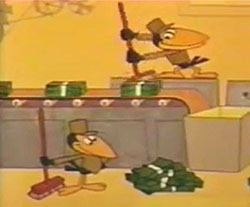 The mint is fully automated, excepting one moving part – Dimwit, who, as sole live security guard, remains in charge of pressing a button to release the robot from its chamber. The robot’s task is to beat up on anyone who has the money (mostly with boxing gloves worn on a set of rotating robotic arms), and to vacuum up the stolen money for return to its proper place. The magpies enter the mint in a variety of disguises (janitors, plumbers, delivery men, ambulance drivers, and finally as fire fighters), each new role calculated to provide an avenue to access to the money, and a unique means of smuggling it out. Infallibly, just as Dimwit becomes cognizant enough of the plot underfoot to press the button for the robot, the magpies let loose the money, allowing it to fall into Dimwit’s hands, leaving the dog “holding the bag” to take the beating from the robot. As firemen, the magpies enter carrying a hose, placing one end into the printing room. Rather than turn on water from the nozzle, Jeckle uses the hose in reverse, stuffing stacks of dollar bills into the nozzle and allowing them to slide down the length of the gose to Heckle, who allows the money to fall out of the hose into a satchel. Jeckle banters in a commanding official style, shouting to make sure the hose doesn’t get clogged, while Heckle reports the flow to be doing fine. Dimwit spots the curious reverse flow, and grabs Heckle. “You’re interferin’ with the fire department”, Heckle protests. Meanwhile, Jeckle takes care of things, by pressing the button himself to summon the robot, just as Dimwit lays his hands on the money. Dimwit realizes he’s in for another thrashing, and waves a meek “bye-bye” to the camera before getting clobbered. As a result of their efforts to save the taxpayers money, H&J are presented with medals of honor, for risking their lives and facing danger. “Risking their lives and facing danger?” complains a black-eyed Dimwit from a window above the ceremony, until he gets an idea. From the window, he tosses out a sack of money, calling out “Here boys. Catch.” The magpies suddenly find themselves in possession of the sack, and Dimwit presses the button. Finally, things are as they should be, with the robot pursuing the magpies over the farthest hills, for the fade out.
The mint is fully automated, excepting one moving part – Dimwit, who, as sole live security guard, remains in charge of pressing a button to release the robot from its chamber. The robot’s task is to beat up on anyone who has the money (mostly with boxing gloves worn on a set of rotating robotic arms), and to vacuum up the stolen money for return to its proper place. The magpies enter the mint in a variety of disguises (janitors, plumbers, delivery men, ambulance drivers, and finally as fire fighters), each new role calculated to provide an avenue to access to the money, and a unique means of smuggling it out. Infallibly, just as Dimwit becomes cognizant enough of the plot underfoot to press the button for the robot, the magpies let loose the money, allowing it to fall into Dimwit’s hands, leaving the dog “holding the bag” to take the beating from the robot. As firemen, the magpies enter carrying a hose, placing one end into the printing room. Rather than turn on water from the nozzle, Jeckle uses the hose in reverse, stuffing stacks of dollar bills into the nozzle and allowing them to slide down the length of the gose to Heckle, who allows the money to fall out of the hose into a satchel. Jeckle banters in a commanding official style, shouting to make sure the hose doesn’t get clogged, while Heckle reports the flow to be doing fine. Dimwit spots the curious reverse flow, and grabs Heckle. “You’re interferin’ with the fire department”, Heckle protests. Meanwhile, Jeckle takes care of things, by pressing the button himself to summon the robot, just as Dimwit lays his hands on the money. Dimwit realizes he’s in for another thrashing, and waves a meek “bye-bye” to the camera before getting clobbered. As a result of their efforts to save the taxpayers money, H&J are presented with medals of honor, for risking their lives and facing danger. “Risking their lives and facing danger?” complains a black-eyed Dimwit from a window above the ceremony, until he gets an idea. From the window, he tosses out a sack of money, calling out “Here boys. Catch.” The magpies suddenly find themselves in possession of the sack, and Dimwit presses the button. Finally, things are as they should be, with the robot pursuing the magpies over the farthest hills, for the fade out.
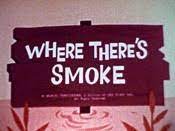 Where There’s Smoke (Terrytoons/Fox, Deputy Dawg, 2/1/62 – Bob Kuwahara, dir.).- Yes, I confess to lifting the title from this picture for this trail, remembering viewing of this episode, and many listens to an original cast record derived therefrom, in my childhood. As Muskie Muskrat and Vincent Van Gopher look to fill their day’s schedule with “anything that’s fun”, they find the opposite – an emergency, in the form of the Sheriff’s tool shed burning down. They race to the Sheriff’s office, where Deputy Dawg is in his usual state of alertness – sound asleep. Nothing will rouse him, except pulling out from under him the bucket on which he sits. “Dag nab it, Muskie! How many times I told you to wake me up slow, boy?” Between Deputy’s yawns and blustering, Muskie finally gets a word in edgewise, and tells him “The cotton pickin’ too; shed’s burning down.” “Why didn’t you tell me?”, snaps Deputy into realization. Deputy races into a large structure with sign reading “Fire Hall”, and emerges with buckets hooked on each hand and foot, and one over his head, calling for a bucket brigade. Muskie and Vince carry buckets to the creek, then up the banks to the tool shed, but their meager efforts have little effect. Make that no effect when it comes to Vincent, who, suffering from poor eyesight above ground, showers Deputy with his bucket instead of the fire, then comments that Deputy is, after all, kinda built like a tool shed. Muskie meanwhile has scooped up a pail of water with a catfish in it – the dream of every red-blooded Southerner. His catch completely distracts Deputy from their purpose, as Deputy tries to assist when the catfish jumps out of the pail and flaps its way back to the creek. The Sheriff arrives, catching Deputy “wet-handed” with his arms in the creek, still trying to catch the catfish, while the unattended tool shed is now reduced to cinders. The Sheriff threatens Deputy to immediately train a crew of volunteer firemen, or lose his job. Ar the sound of this ultimatum, Muskie and Vince attempt a hasty exit. “What’s a ‘volunteer fireman’, Muskie?”, asks Vincent. “It’s work. That’s what it is”, responds Muskie. Deputy races ahead of them and blocks their escape, insisting he needs a fire crew. “A volunteer has to be voluntary, and we ain’t volunteering”, states Muskie – until Deputy points his pistol at the two of them, changing their mind quickly. “We just became voluntary.”
Where There’s Smoke (Terrytoons/Fox, Deputy Dawg, 2/1/62 – Bob Kuwahara, dir.).- Yes, I confess to lifting the title from this picture for this trail, remembering viewing of this episode, and many listens to an original cast record derived therefrom, in my childhood. As Muskie Muskrat and Vincent Van Gopher look to fill their day’s schedule with “anything that’s fun”, they find the opposite – an emergency, in the form of the Sheriff’s tool shed burning down. They race to the Sheriff’s office, where Deputy Dawg is in his usual state of alertness – sound asleep. Nothing will rouse him, except pulling out from under him the bucket on which he sits. “Dag nab it, Muskie! How many times I told you to wake me up slow, boy?” Between Deputy’s yawns and blustering, Muskie finally gets a word in edgewise, and tells him “The cotton pickin’ too; shed’s burning down.” “Why didn’t you tell me?”, snaps Deputy into realization. Deputy races into a large structure with sign reading “Fire Hall”, and emerges with buckets hooked on each hand and foot, and one over his head, calling for a bucket brigade. Muskie and Vince carry buckets to the creek, then up the banks to the tool shed, but their meager efforts have little effect. Make that no effect when it comes to Vincent, who, suffering from poor eyesight above ground, showers Deputy with his bucket instead of the fire, then comments that Deputy is, after all, kinda built like a tool shed. Muskie meanwhile has scooped up a pail of water with a catfish in it – the dream of every red-blooded Southerner. His catch completely distracts Deputy from their purpose, as Deputy tries to assist when the catfish jumps out of the pail and flaps its way back to the creek. The Sheriff arrives, catching Deputy “wet-handed” with his arms in the creek, still trying to catch the catfish, while the unattended tool shed is now reduced to cinders. The Sheriff threatens Deputy to immediately train a crew of volunteer firemen, or lose his job. Ar the sound of this ultimatum, Muskie and Vince attempt a hasty exit. “What’s a ‘volunteer fireman’, Muskie?”, asks Vincent. “It’s work. That’s what it is”, responds Muskie. Deputy races ahead of them and blocks their escape, insisting he needs a fire crew. “A volunteer has to be voluntary, and we ain’t volunteering”, states Muskie – until Deputy points his pistol at the two of them, changing their mind quickly. “We just became voluntary.”
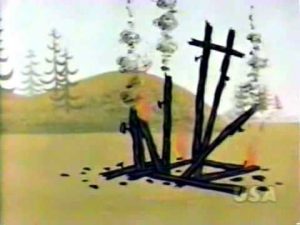 Deputy and his new crew wheel from the Fire Hall their only piece of true fire-fighting equipment- an ancient pumper engine intended to be pulled by a horse (which they don’t have), that Vincent observes looks like it hasn’t been moved in 80 years. As Deputy orders the boys to fill up the pumper’s water tank and polish her up, a city slicker arrives on the scene, reacting with a “Wow” upon seeing the old engine. “I’d heard there was an old Peoria Pumper down here, and now I’ve found her.” The engine is the first that the Peoria Pumper company ever built, and is wanted for a company museum. “She’s all the equipment we got, mister”, responds, Deputy, unable to agree to an outright sale. The man responds with an appealing offer – a trade for the most modern engine the company has in production. Deputy strikes a deal, and the man departs to bring back the new engine, However, before departing, the man, in his haste, lets fall a half-burned cigar, which lands in some high grass next to the fire hall. While Deputy boasts to the boys about his sensational deal, Muskie spots need for some emergency use of the existing equipment, as the fire hall begins to erupt in flames. The trio bumble their way in attempt to operate the antique equipment, with disconnecting hose nozzles, Muskie falling into the pumper reservoir and clogging up the hose, and running out of water supply for the reservoir, until the fire hall is reduced to the same state as the tool shed. “Dag nab it! I hope nothin’ else goes wrong today”, says Deputy, failing to observe a last board of the fire hall, still flaming, fall upon the end of the canvas hose of the pumper. As the brand-spanking-new fire engine intended for the trade rolls up over the hills, the boys marvel at its glitz and deluxe features – failing to observe that the fire has followed the hose like a fuse, and is burning down the Peoria Pumper. As the old engine collapses into a shambles, Deputy shyly suggests, “You’re still gonna let us have this new model, aren’t ya, sir?” “Yeah, I’m gonna let you have it”, responds the angry man, opening the valve on the hose nozzle, and blasting Deputy in the face with water. He takes back the new engine, departing over the hills from whence he came, while the prone Deputy moans, “Today just doesn’t seem to be my day. Phew!”
Deputy and his new crew wheel from the Fire Hall their only piece of true fire-fighting equipment- an ancient pumper engine intended to be pulled by a horse (which they don’t have), that Vincent observes looks like it hasn’t been moved in 80 years. As Deputy orders the boys to fill up the pumper’s water tank and polish her up, a city slicker arrives on the scene, reacting with a “Wow” upon seeing the old engine. “I’d heard there was an old Peoria Pumper down here, and now I’ve found her.” The engine is the first that the Peoria Pumper company ever built, and is wanted for a company museum. “She’s all the equipment we got, mister”, responds, Deputy, unable to agree to an outright sale. The man responds with an appealing offer – a trade for the most modern engine the company has in production. Deputy strikes a deal, and the man departs to bring back the new engine, However, before departing, the man, in his haste, lets fall a half-burned cigar, which lands in some high grass next to the fire hall. While Deputy boasts to the boys about his sensational deal, Muskie spots need for some emergency use of the existing equipment, as the fire hall begins to erupt in flames. The trio bumble their way in attempt to operate the antique equipment, with disconnecting hose nozzles, Muskie falling into the pumper reservoir and clogging up the hose, and running out of water supply for the reservoir, until the fire hall is reduced to the same state as the tool shed. “Dag nab it! I hope nothin’ else goes wrong today”, says Deputy, failing to observe a last board of the fire hall, still flaming, fall upon the end of the canvas hose of the pumper. As the brand-spanking-new fire engine intended for the trade rolls up over the hills, the boys marvel at its glitz and deluxe features – failing to observe that the fire has followed the hose like a fuse, and is burning down the Peoria Pumper. As the old engine collapses into a shambles, Deputy shyly suggests, “You’re still gonna let us have this new model, aren’t ya, sir?” “Yeah, I’m gonna let you have it”, responds the angry man, opening the valve on the hose nozzle, and blasting Deputy in the face with water. He takes back the new engine, departing over the hills from whence he came, while the prone Deputy moans, “Today just doesn’t seem to be my day. Phew!”
The end of the theatrical era, next time.


 Charles Gardner is an animation enthusiast who toils by day as a member of LA Law – but by nights and weekends indulges in classic jazz and ragtime as a performer; and studies classic Hollywood cartoons… maybe a little too much.
Charles Gardner is an animation enthusiast who toils by day as a member of LA Law – but by nights and weekends indulges in classic jazz and ragtime as a performer; and studies classic Hollywood cartoons… maybe a little too much.


































































































































































The balding, spectacled, unsmiling man in the audience at the circus in “Jolly the Clown” bears a strong resemblance to Izzy Sparber. I’ve read that Izzy, if not exactly humorless, wasn’t much fun to be around — doing paperwork by himself while the office Christmas party was going on, that sort of thing. He was one of twenty staff members laid off in January 1957, so he wouldn’t have been around to take umbrage at the caricature. If that man in the cartoon is meant to represent any real-life person, my money’s on Izzy.
It occurs to me, after watching “Where There’s Smoke”, that one could play a drinking game while watching Deputy Dawg cartoons. Have a shot of Jack Daniels every time he says “Dag nab it”, and one of Southern Comfort whenever someone says “cotton picking”. It couldn’t help but make the cartoons more amusing. Phew!
Milt Kahl never seemed much a nice guy to me.
What does that have to do with anything here?
While “Spooking About Africa” (Paramount, Casper the Friendly Ghost, 4/1/57 — Seymour Kneitel, dir.), Casper is unable to make friends with any of the jungle animals. Neither is Wheezy, a young elephant with a cold, whose sneezes are wreaking havoc. So the two unlikable misfits are a perfect match. Casper tries to stop Wheezy’s sneezing by burying the end of his trunk in the ground, but he blasts out a sneeze that uproots a stand of palm trees. Casper then ties a knot in Wheezy’s trunk, but the next sneeze inflates it like a balloon and he floats away. After Casper helps him back to earth and unties the knot, he finds a feather stuck in Wheezy’s trunk; and by removing it, he solves the elephant’s problem.
Now the two friends encounter a stampede of frightened animals fleeing a forest fire. Casper urges Wheezy to sneeze and blow the fire out, but now that his trunk is clear, he can’t do it. But when a flock of birds passes by and one of them sheds a feather, Casper grabs it and places it in Wheezy’s trunk. A-choo! He puts out the forest fire as easily as blowing out the candles on a birthday cake. All the jungle animals cheer for Wheezy, but another sneeze sends them tumbling head over heels. Casper pulls out the feather before the elephant can do any further damage, and they simper at each other for the iris out.
Really? A whole cartoon about sneezing, and not a single “Gesundheit!”???
Slightly off-topic, but I was under the impression than Gerald was lip-syncing to an off-screen boy in “Magoo’s Christmas Carol”.
Ha, I do like that idea, but remember that after their production is over, from the wings Gerald yells at Magoo to “turn around!” while he’s taking his bow
Maybe an original version of Red Hot Riding Hood will turn up one day.
I’d sure like to see it.
I like the Heckle and Jeckle short “Mint Men” It’s a good entry in their series of shorts, and it’s high quality too.
“The Brave Little Brave” (Fox/Terrytoons, July 1956 — Mannie Davis, dir.) wants to join the men of his tribe in hunting a bull moose that has been harassing their village. But when the chief insists that he stay at home, the boy secretly sets out on his own with his toy bow and arrow. After a series of misadventures in the woods, he finally comes face to face with the moose, who chases him to the edge of a cliff. Trapped without an escape route, the boy prays for deliverance, and a bolt of lightning shoots out of the sky and strikes a tree, setting it on fire. The tree falls and pins the moose down by one antler as the flames burn higher.
The boy can’t bring himself to leave the moose to face a fiery death. He tries to lift the fallen tree, but it’s too heavy. He tries to stamp the fire out with his moccasins. He fills his hat with water from a nearby stream, but it all leaks out before he can pour it on the flames. And meanwhile the fire keeps spreading through the forest.
Finally he has a brainstorm. Taking a length of rope that has been conveniently coiled inside his hat, the boy slings it over a tree branch, ties one end to the burning log holding the moose down and the other to a boulder on the edge of the cliff. Then, placing himself bodily in his bow, he propels himself like an arrow into the boulder, knocking it off the cliff; it acts as a counterweight to lift the burning log and thereby frees the moose. But the boy is knocked unconscious in the process.
The moose runs to the stream and gulps down water until he is swollen to almost spherical proportions. Then, sitting down in the middle of the forest fire with a grin, he spins his antlers around on top of his head while water squirts out of their points like a sprinkler, extinguishing the blaze. Which is something I bet you never thought moose could do.
When the hunters find the boy’s hat in the middle of the scorched forest, they fear the worst. But here he comes, riding on the back of the moose! For his bravery in taming the moose, he is given a feather headdress and the title of Big Chief Moosehead.
One of the better cartoons from Terry’s Cinemascope period, hearkening back to the studio’s glory days of ten to fifteen years earlier. Not to be confused with the Yogi Bear cartoon of the same title.
A nice catch, Paul. An “A” list Terrytoon I’d neglected over the years. Director Mannie Davis must have exercised tight quality control, as in his days when he could turn out a nice-looking Cubby Bear amidst otherwise routine Van Buren product, as the drawings remain cleanly on-model, with no sign of Jim Tyer looseness. The Moose animation is very realistic for the studio, far superior to H&J’s “Moose on the Loose”. Probably heavily inspired by Disney’s “Little Hiawatha”, the plot doesn’t hold up badly in comparison, and character designs come remarkably close in appeal to rival models from Indian designs at Famous across town. Also Disneyesque in avoiding gags too far from the realm of plausibility – excepting the moose’s sprinkler-head gag, which is forgivable for its originality. It’s be nice if this film turned up in its original Cinemascope, it which I imagine it looked reasonably impressive.
Pretty good choices this time. Magoo Meets McBoing-Boing is Saturday-morning-esque. Not UPA at its finest-as rare a time that was. Speaking of UPA, Dante Dreamer is scary as a Gerald ripoff. Blackboard Jumble is one of the better Lah cartoons. He was an A+ animator but an okay director. All the Terrytoons were good!
The Red Riding Hoodlum incident with Avery is weird; just yesterday I reported on Avery’s lost Lantz films: https://buddyscartoons.blogspot.com/p/the-lost-tex-averys.html
Will you be mentioning the fire sequences in Disney’s Jungle Book & Robin Hood & Don Bluth’s An American Tail?